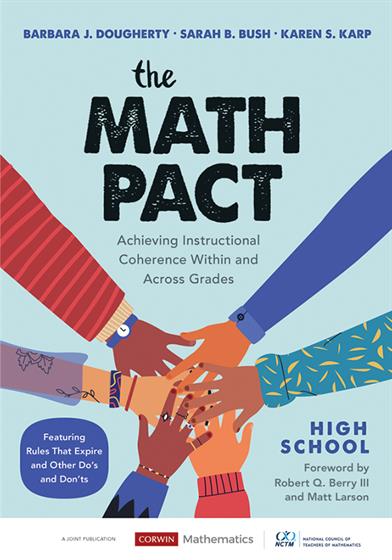Quote by Jessica Ivy, Bellarmine University: "The Math Pact is the perfect resource for groups who are seeking to put students first and create cohesive, thoughtful agreements to support students’ learning of mathematics. The Math Pact leverages the NCTM Mathematics Teaching Practices to encourage mathematics teaching that is grounded in effectiveness and puts learning at the forefront of decision making. As a mathematics teacher educator, I appreciate the stress on the precision and consistency with mathematical vocabulary, notation, and meaning-making. The strategies stressed in The Math Pact align with the collaborative and professional nature of teaching—that is, teachers work best when they are working as a cohesive team. Sending the same message to students is appreciated by teachers, administrators, coaches, students, and parents.
The structure of The Math Pact offers opportunities for learning communities to reflect and foster change through learning, discourse, and action. From overarching ideas such as “no teaching by telling” to more intricate details, such as considering the frequency, purpose, and nature of homework assignments, The Math Pact provides insight into a myriad of mathematical issues that allow teams to construct Mathematics Whole School Agreements that consider the nature and needs of their students and promote efficiency and consistency."
"The Math Pact is the perfect resource for groups who are seeking to put students first and create cohesive, thoughtful agreements to support students’ learning of mathematics. The Math Pact leverages the NCTM Mathematics Teaching Practices to encourage mathematics teaching that is grounded in effectiveness and puts learning at the forefront of decision making. As a mathematics teacher educator, I appreciate the stress on the precision and consistency with mathematical vocabulary, notation, and meaning-making. The strategies stressed in The Math Pact align with the collaborative and professional nature of teaching—that is, teachers work best when they are working as a cohesive team. Sending the same message to students is appreciated by teachers, administrators, coaches, students, and parents.
The structure of The Math Pact offers opportunities for learning communities to reflect and foster change through learning, discourse, and action. From overarching ideas such as “no teaching by telling” to more intricate details, such as considering the frequency, purpose, and nature of homework assignments, The Math Pact provides insight into a myriad of mathematical issues that allow teams to construct Mathematics Whole School Agreements that consider the nature and needs of their students and promote efficiency and consistency."
Jessica Ivy
Bellarmine University




